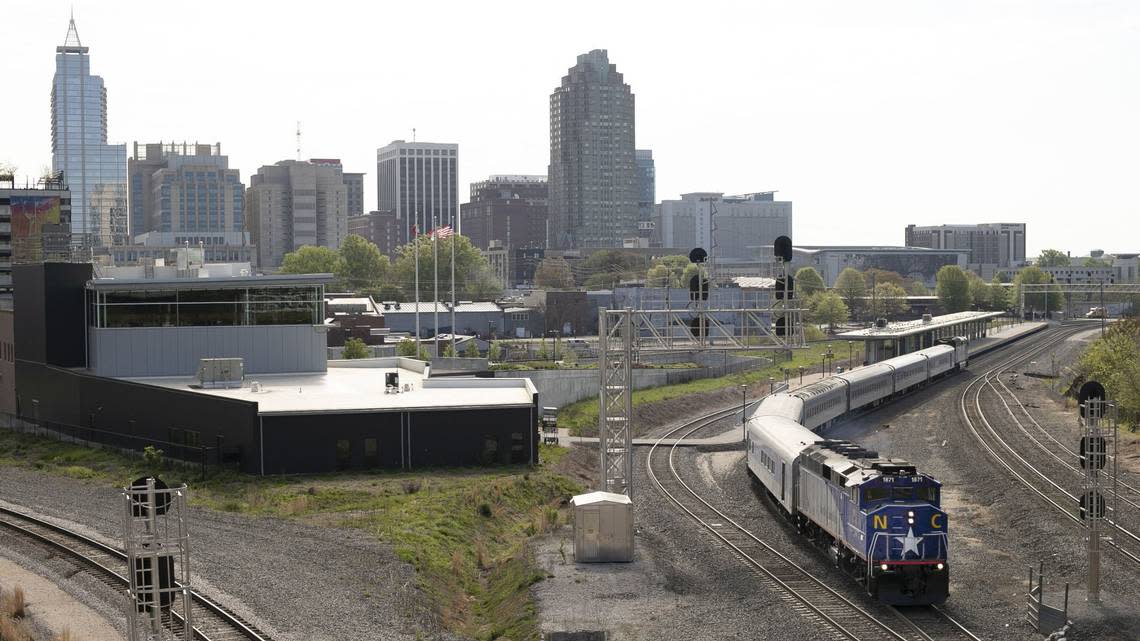Durham gets first glimpse of commuter rail study, and $3 billion price tag
A new study predicts a commuter rail line in the Triangle could cost around $3 billion and take over a decade to launch.
The route extending up to 43 miles would have a start date between 2033 and 2035 and provide 12,000 to 18,000 trips per day by 2040, GoTriangle leaders told the Durham County Board of Commissioners on Tuesday.
The planned route would start in West Durham and stop in downtown Durham, East Durham, on Ellis Road and in Research Triangle Park. From there, trains would stop in Morrisville and twice in Cary before heading into Raleigh, with stops at Blue Ridge Road, N.C. State, downtown and Hammond Road, before heading to Garner and potentially the Auburn community in Wake County and Clayton.
“We want to get from West Durham to Clayton,” said Charles Lattuca, president and CEO of GoTriangle. “I think that’s what the region needs for the long term.”
Lattuca said adding stops in phases is a possibility.
Commissioners Vice-Chair Wendy Jacobs said a phased approach was a “no-brainer” and that Durham needs to be in the first phase.
“We have skin in the game. We’ve been working on this for a long time,” Jacobs said. “We talk about the issues, but we don’t talk about the costs of not moving forward.”
Chair Brenda Howerton agreed.
“We’re feeling the urgency here in Durham,” Howerton said. “This has got to happen, and we cannot just keep talking about, ‘It’s hard.’ Jesus.”

Lattuca assured commissioners he didn’t see the first phase happening without both Durham and Raleigh.
The Triangle’s population is expected to swell by 1 million people (and 1 million cars) by 2050, according to the Triangle Regional Model.
Lattuca said 800,000 new jobs were projected in the same time frame and 350,000 would be located near the rail line.
Unlike failed light rail, commuter rail system would share tracks
The feasibility study led GoTriangle to revise commuter rail cost estimates upward to between $2.8 and $3.2 billion, plus $42 million per year to operate and maintain.
Unlike the failed light rail project, the commuter rail would share tracks with Norfolk Southern and CSX freight trains, existing and planned Piedmont trains, and long-distance Amtrak trains.
Light rail would have spanned 18 miles in Durham and Orange counties. This idea failed amid opposition from Duke University, but not before $157 million was spent on the project, GoTriangle reported.
A double track, two railways in either direction, would need to be laid down along most of the route to accommodate the freight and passenger train traffic.
GoTriangle reports the greatest number of obstacles to implementation in Durham:
The double track would need to extend an additional 3 miles west of Durham.
There’s no consensus yet on the design for the new tracks in downtown Durham.
Placing a station in East Durham near Durham Tech would require closing a portion of Plum Street.
A third track would be needed near the freight yard in East Durham, which would require closing a stretch of Driver Street.
A location must be chosen for the RTP station.
Durham and Wake counties’ half-cent transit sales taxes won’t cover the cost, and the extent of Johnston County’s involvement is unclear. The extent of available federal funding is uncertain, said Katharine Eggleston, GoTriangle’s chief development officer.
“I want us to go after every single solitary piece of money,” Commissioner Nimasheena Burns said.
A 2020 eight-agency agreement said $6 million would come from Wake, $2.7 million from Durham and $250,000 from Johnston.
Commissioner Heidi Carter said she no longer knew whether commuter rail was feasible given the state of financial planning.
“The funding is always the issue,” Lattuca replied. “There are lots of grants out there and the Bipartisan Infrastructure Law did provide more opportunities.”
There will be a 45 day public input period after the GoTriangle Board formally accepts the results of the study later this month.
The Durham Report
Calling Bull City readers! We've launched The Durham Report, a free weekly digest of some of the top stories for and about Durham published in The News & Observer and The Herald-Sun. Get your newsletter delivered straight to your inbox every Thursday at 11 a.m. featuring links to stories by our local journalists. Sign up for our newsletter here. For even more Durham-focused news and conversation, join our Facebook group "The Story of my Street."
